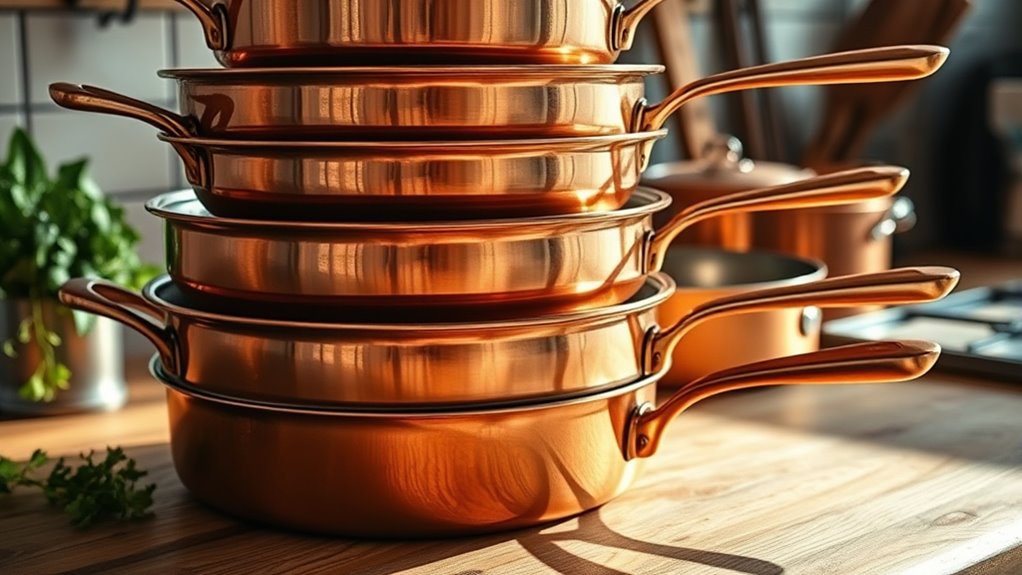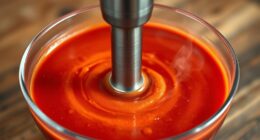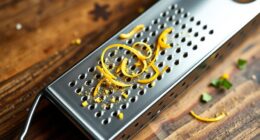Copper cookware is making a stunning comeback in modern kitchens because of its exceptional heat responsiveness, even heat distribution, and striking appearance. Its timeless look adds style, while innovative designs like lightweight, multi-layered pieces appeal to contemporary tastes. Plus, its rich heritage and artisanal craftsmanship connect you to culinary tradition. With proper care and updated styles, copper remains both functional and beautiful—if you want to discover how to incorporate this timeless material into your kitchen, there’s more to explore.
Key Takeaways
- Copper cookware offers superior heat responsiveness and even distribution, ensuring precise temperature control for delicate culinary tasks.
- Its vintage aesthetic and artisanal craftsmanship add a stylish, decorative element to modern kitchen designs.
- Contemporary innovations include lightweight, multi-layered constructions with modern finishes, blending tradition with modern aesthetics.
- Proper maintenance and re-tinning preserve copper’s functionality and appearance, supporting sustainability and heirloom-quality use.
- The rich heritage and timeless appeal of copper continue to attract both professional chefs and home cooks, fueling its modern resurgence.
The Historical Significance of Copper in Culinary Arts
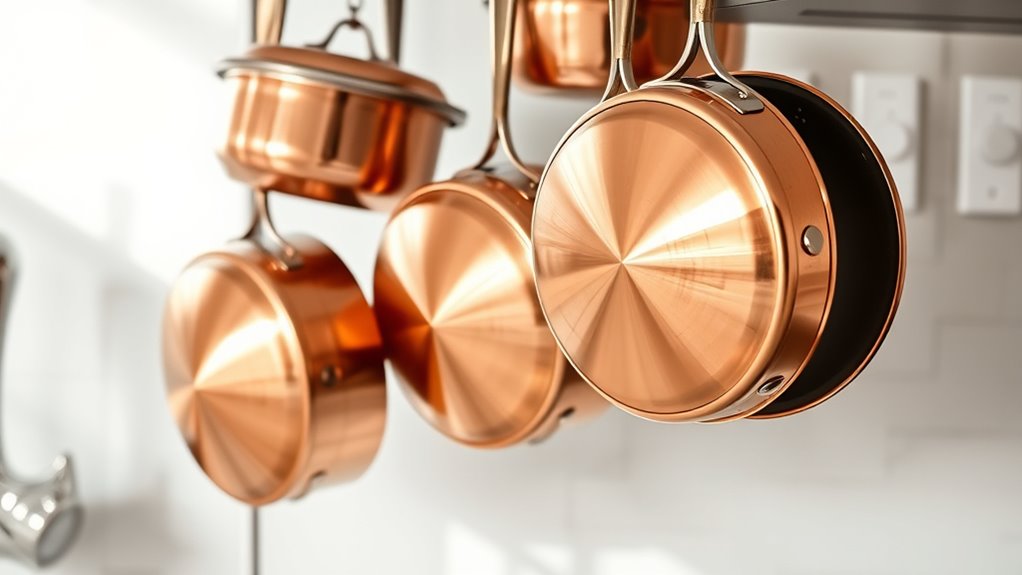
Copper has played an essential role in culinary history for thousands of years, showcasing its enduring importance. Throughout this long tradition, copper has been valued for its exceptional heat conduction, especially in medieval Europe, where chefs relied on it for precise temperature control. Its cultural significance extends beyond cooking; ancient civilizations like the Egyptians, Chinese, and Indians used copper vessels for medicinal, ritual, and culinary purposes, highlighting its broader importance. In Europe, especially during the Renaissance, handcrafted copper cookware became a symbol of craftsmanship and culinary excellence, often associated with royalty and aristocracy. Additionally, the development of copper cookware techniques over centuries reflects its integral role in culinary innovation. The aesthetic appeal of copper also contributed to its status, making it a prized material for both functionality and decorative purposes. The longevity and durability of copper cookware further underline its value, as many historic pieces remain in use or as collectibles today. Moreover, the resurgence of copper in modern kitchens underscores its timeless appeal and the importance of traditional craftsmanship in maintaining its quality. By understanding this history, you see copper not just as a material but as a key element shaping culinary arts and cultural identities across different eras.
Factors Driving the Modern Resurgence of Copper Cookware
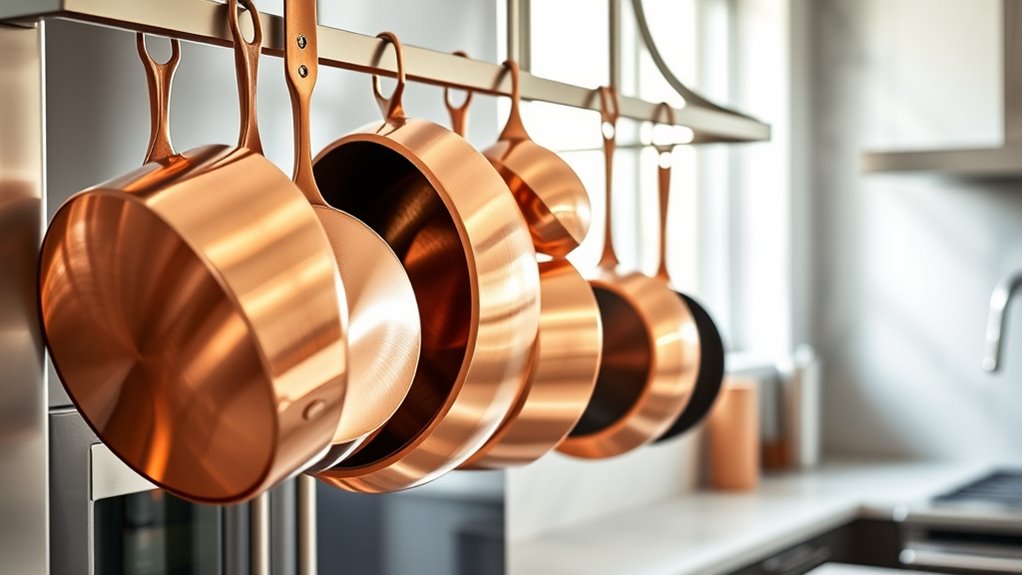
You’re drawn to copper cookware for its exceptional ability to provide precise temperature control, making cooking easier and more accurate. Its shiny, vintage look adds a stylish touch to your kitchen and connects you to culinary traditions. Plus, modern innovations and health benefits are fueling its renewed popularity among both amateurs and professionals. The superior color accuracy of copper also ensures that your dishes look as good as they taste, elevating your overall cooking experience. Additionally, the thermoregulating properties of copper help maintain consistent heat distribution, further enhancing cooking precision. Copper’s reactivity with certain foods can be managed with proper lining, ensuring safety and durability for everyday use. As awareness of copper’s health benefits grows, more cooks are embracing its advantages in the modern kitchen.
Culinary Precision and Control
The key to achieving perfect results in delicate culinary tasks lies in precise temperature control, and that’s where copper cookware excels. Its exceptional thermal conductivity—up to twenty times greater than stainless steel—lets you respond instantly to heat adjustments, giving you precise temperature control. This responsiveness minimizes overcooking and helps you achieve ideal textures in sauces, chocolates, and custards. Copper’s even heat distribution ensures no hot spots, resulting in consistent cooking and better flavor development in complex recipes. Because heat transfer is fast and accurate, copper cookware is especially valued for techniques that demand exact temperature management. This ability to fine-tune heat makes copper a top choice for chefs and home cooks who prioritize culinary precision and control in their kitchen. Thermal conductivity is a crucial factor that sets copper apart from other materials used in cookware. Additionally, its rapid heat response allows for better control over cooking processes, which is essential for precision cooking techniques that require meticulous temperature adjustments.
Aesthetic and Heritage Appeal
With its gleaming and timeless appearance, copper cookware instantly enhances kitchen decor, blending vintage charm with modern style. Its heritage-rich reputation, exemplified by brands like Mauviel and classic French pieces, appeals to those seeking a connection to culinary traditions. The resurgence emphasizes artisanal craftsmanship, showcasing handcrafted, high-quality copper that highlights traditional techniques. Many use copper as a decorative statement, integrating it into kitchen aesthetics that balance functionality with visual appeal. This revival is fueled by a growing appreciation for heirloom-quality, sustainable materials that bridge the gap between cultural legacy and contemporary design. Additionally, the increasing popularity of traditional techniques underscores the importance of craftsmanship and authenticity in modern cookware. The focus on artisanal craftsmanship further reinforces its appeal, emphasizing the importance of traditional techniques and quality. As a result, copper cookware not only elevates your cooking experience but also adds an authentic, stylish touch that celebrates heritage and timeless elegance in your kitchen. Furthermore, consumer interest in sustainable materials underscores the shift towards environmentally conscious purchasing choices.
The Unique Thermal Properties That Make Copper a Chef’s Favorite
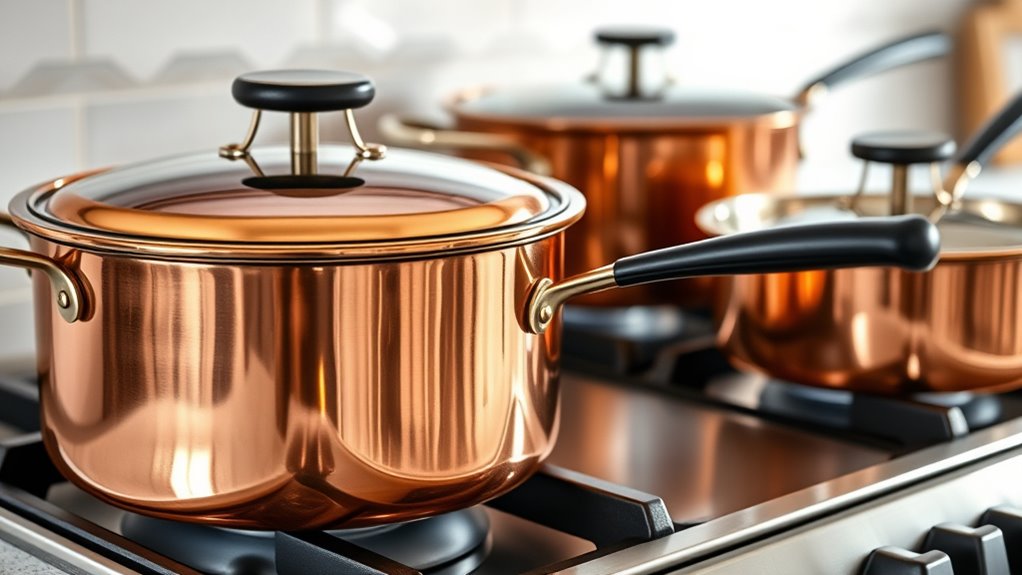
Copper’s exceptional thermal conductivity means you can heat your pans quickly and adjust temperatures with pinpoint accuracy. Its ability to distribute heat evenly prevents hot spots, giving you consistent results every time. When cooking delicate ingredients, copper responds instantly to changes, reducing the risk of overcooking or burning.
Precise Temperature Control
Thanks to its exceptional thermal conductivity, copper heats up and cools down almost instantly, giving you precise control over cooking temperatures. This responsiveness allows you to adjust heat levels quickly, reducing the risk of overcooking or burning. Copper’s even heat distribution ensures consistent results, eliminating hot spots that can ruin dishes. Its high conductivity responds instantly to temperature changes, making delicate sauces and slow-cooked dishes easier to manage. The table below highlights copper’s thermal advantages:
| Property | Benefit | Result |
|---|---|---|
| Thermal Conductivity | Rapid heat transfer | Precise temperature control |
| Heat Response | Instant adjustment | Avoids overcooking or burning |
| Even Heat Distribution | Consistent cooking | Uniform results |
| Responsiveness | Fast reaction to heat changes | Fine-tuned culinary techniques |
| Temperature Stability | Maintains set heat levels | Complex recipes perfected |
Additionally, understanding thermal properties can help chefs optimize their cooking techniques with copper cookware.
A better grasp of heat transfer mechanisms enables chefs to improve their timing and precision during cooking processes.
Rapid Heat Response
The remarkable thermal properties of copper make it a favorite among professional chefs, enabling rapid and precise responses to heat changes. Copper conducts heat exceptionally well—up to twenty times better than stainless steel—allowing it to heat up quickly when exposed to a heat source. This rapid heat response means you can adjust the temperature instantly, giving you better control over your cooking. Copper also conducts heat evenly across its surface, minimizing hot spots and ensuring your food cooks uniformly. Once removed from the heat, it cools just as fast, preventing overcooking. This combination of quick heating and cooling helps you avoid burning delicate ingredients like sauces or chocolates. Additionally, copper’s thermal conductivity ensures that heat distribution remains consistent, adding to its reputation as a professional-grade cookware material. Its reactivity to certain foods can be managed with proper lining, making it versatile for various culinary tasks. Overall, copper’s ability to heat evenly and respond swiftly makes it an indispensable tool for precise, professional-level cooking.
The Art and Craftsmanship Behind Vintage and Contemporary Copper Pieces
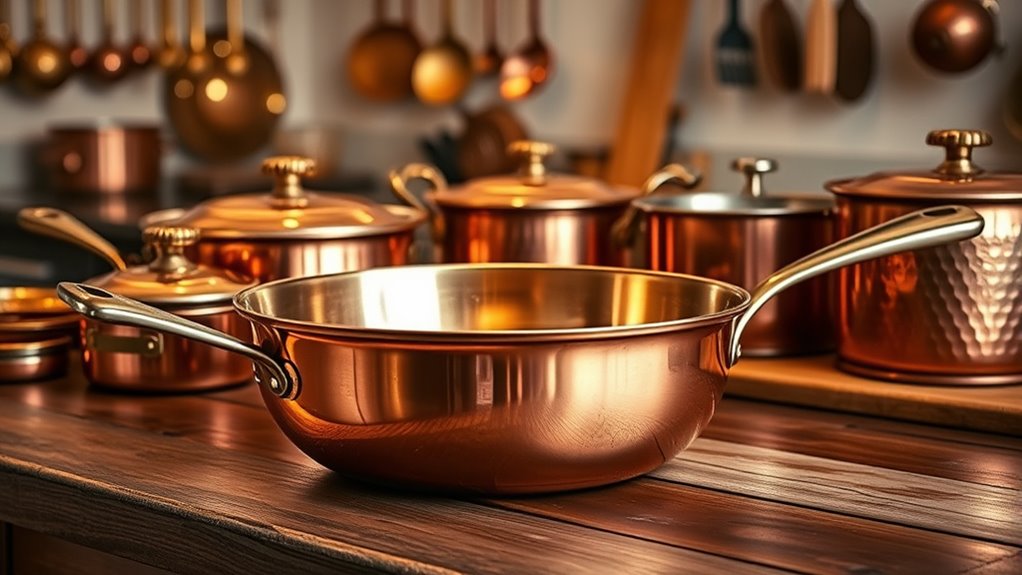
Vintage copper cookware showcases a level of craftsmanship that’s hard to find today, as skilled artisans use traditional techniques like spinning, hammering, and hand-soldering to create functional art pieces. This artisanal craftsmanship guarantees each piece is unique, blending beauty with durability. Skilled restorers carefully recondition antique copper cookware, re-tinning and polishing to revive its original luster and performance. Contemporary copper pieces often incorporate intricate designs, custom engravings, and high-quality linings such as tin or stainless steel, reflecting a seamless blend of old-world artistry and modern functionality. Whether vintage or new, these pieces celebrate the mastery of craftsmanship passed down through generations. The artistry behind each item highlights the enduring appeal of copper cookware, rooted in centuries of tradition and skill.
Innovations and Trends in Copper Cookware Design
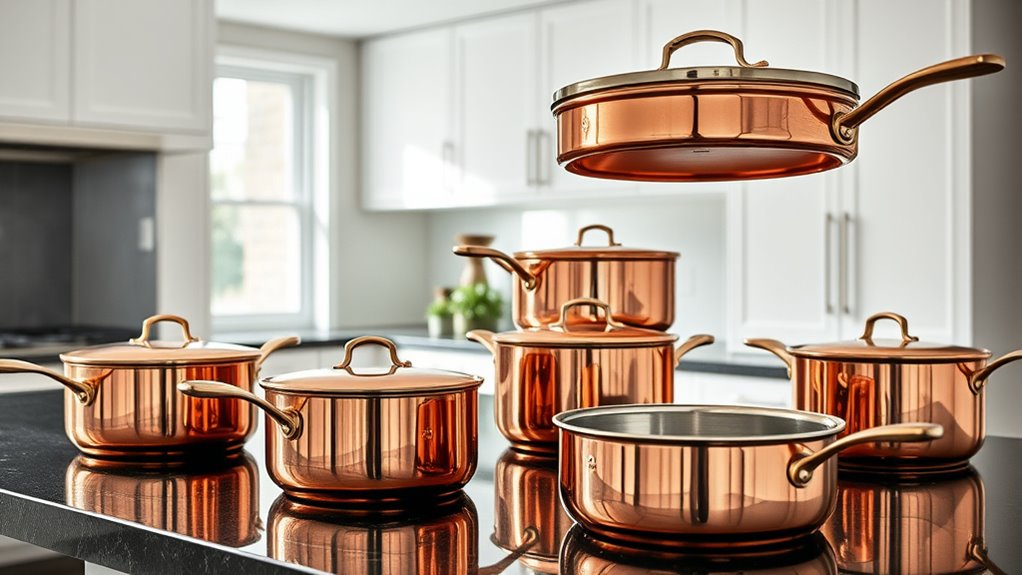
Modern copper cookware embraces a blend of tradition and innovation, incorporating sleek, lightweight designs with durable stainless steel or silver linings that make them suitable for induction stoves. Copper vessels now feature innovative manufacturing techniques like precision rolling and hand-hammered textures, enhancing aesthetic appeal while maintaining excellent heat conduction. Modern designs also prioritize functionality, with ergonomic, heat-resistant handles and decorative etching that blend craftsmanship with comfort. Many brands use multi-layered constructions, combining copper with aluminum or steel, which improves durability and makes maintenance easier without sacrificing thermal responsiveness. Additionally, customizable finishes like matte or brushed textures allow you to match your cookware to your kitchen’s aesthetic, reflecting current trends in upscale culinary markets. These innovations keep copper cookware both stylish and highly functional.
Proper Maintenance and Care for Longevity and Shine

Maintaining the shine and longevity of your copper cookware requires regular care and proper handling. To keep your copper pots and pans looking their best, wash them with warm, soapy water and dry immediately to prevent tarnishing. Periodically, use lemon juice and salt or commercial copper cleaners to gently polish and restore their gleam. Avoid abrasive scrubbers or harsh chemicals that can scratch or damage the copper surface, preserving its appearance and integrity. Over time, re-tinning or re-lining your copper cookware—typically every 10-15 years—helps prevent exposure of reactive copper and ensures ideal performance. Store your copper pots and pans in a dry, protected environment, preferably hanging or in a soft-lined cabinet, to prevent dents and tarnish buildup, prolonging their beauty and functionality.
Comparing Copper Linings: Tin, Stainless Steel, and Silver

When choosing copper cookware, the lining material plays a crucial role in its performance and longevity. Copper linings like tin, stainless steel, and silver each offer unique benefits. Tin linings are traditional; they’re inert and non-reactive, providing a natural nonstick surface. However, they’re soft and can wear out over time, requiring careful heat management due to their low melting point (~450°F). Stainless steel linings are more durable and resistant to wear, making them ideal for daily use, but they may cause food to stick more easily. Silver linings excel in heat conduction and are non-reactive, but their high cost and maintenance make them less common. Your choice depends on balancing durability, reactivity, and budget for your cooking needs.
The Role of Copper in Sustainable and Heirloom Kitchen Practices

Copper cookware’s durability makes it a smart choice for sustainable and heirloom kitchen practices. With proper care, it can last for generations, turning into a cherished family piece. Re-tinning and reconditioning extend its lifespan, reducing waste and supporting eco-friendly habits. Copper’s recyclability aligns with eco-conscious sourcing, making it a responsible choice. Incorporating vintage or handcrafted pieces celebrates traditional craftsmanship and boosts local economies. This fosters a circular economy, ensuring your kitchen remains sustainable and timeless. To visualize this, consider the following:
| Aspect | Benefit | Impact |
|---|---|---|
| Re-tinning | Extends lifespan, reduces waste | Eco-friendly, heirloom |
| Reconditioning | Maintains quality, promotes sustainability | Long-lasting, responsible |
| Recyclability | Supports eco-conscious sourcing | Circular economy |
| Craftsmanship | Preserves tradition, boosts local economies | Cultural sustainability |
Choosing copper embraces both sustainability and heirloom values.
How Copper Cookware Enhances Aesthetic and Functional Kitchen Spaces

Copper cookware instantly elevates your kitchen’s aesthetic with its striking, reflective surface that combines vintage charm and luxurious appeal. Copper pans add a bold visual appeal, making them a natural centerpiece whether your kitchen is rustic or modern. Their warm, rich hue complements various interior styles, enhancing the overall decor. Over time, copper develops a unique patina that adds character and visual interest, which you can choose to maintain or let age gracefully. Beyond looks, copper’s exceptional heat conductivity ensures precise cooking, making your kitchen both stylish and functional. Displaying copper pots and pans as decorative elements can turn everyday cookware into statement pieces, showcasing artisanal craftsmanship. This blend of beauty and performance helps create a space that’s both visually stunning and highly efficient.
Frequently Asked Questions
Do Professional Chefs Use Copper Pans?
You might wonder if professional chefs still use copper pans, and the answer is yes. They prefer copper cookware because of its excellent heat responsiveness and even heat distribution, which helps them perfect delicate sauces and complex dishes. Chefs value how quickly they can adjust the temperature, ensuring consistent results. Despite the costs, copper pans remain a top choice in professional kitchens for their performance and aesthetic appeal.
What Is the Downside of Copper Cookware?
So, you think copper cookware is all shiny glamour, right? Well, hold on—there’s a catch. Its reactive nature means you’ll need to line it with stainless steel or tin, which can wear out and require re-tinning. Plus, it tarnishes easily, demanding regular polishing. And don’t forget the hefty price tag and the need for attentive heat control—overheat, and you’re risking burnt meals or damaged pans.
How Do You Make Copper Pans Look New Again?
To make your copper pans look new again, start by cleaning them with a mixture of lemon juice and salt, which naturally removes tarnish. Regularly buff with a soft cloth and commercial copper cleaner or a baking soda and vinegar paste to maintain shine. For deep cleaning, apply ketchup or tomato paste, let it sit briefly, then rinse and buff. Dry thoroughly to prevent spots and tarnish.
What Are the Disadvantages of Copper in the Kitchen?
Imagine preparing a delicate sauce in your copper pan, only to notice discoloration and staining. Copper’s reactive nature means it can leach into acidic foods, raising health concerns. Plus, you’ll find maintaining it is time-consuming and costly, with regular polishing and re-tinning needed. Its softness makes it prone to dents and scratches, and overheating can damage linings. Overall, these downsides make copper less practical for everyday kitchen use.
Why Is Copper Not Used for Most Pans Today?
You might wonder why most pans aren’t made of copper today. The main reasons are cost and practicality. Copper pans are expensive and have doubled in price over the years. They also need regular maintenance like re-tinning. Plus, modern induction stoves don’t work well with traditional copper pots unless modified. Because of these issues, many prefer cheaper, easier-to-maintain materials like stainless steel, aluminum, or ceramic coatings.
Conclusion
As you embrace copper cookware, you’re not just upgrading your kitchen—you’re transforming it into a culinary masterpiece that turns heads and sparks envy. Its timeless beauty and unmatched performance make it a true marvel in modern cooking spaces. With proper care, your copper pieces will shine brighter than the stars, elevating every meal you create. Get ready to cook with the passion and precision of a true artisan—your kitchen will never be the same!
